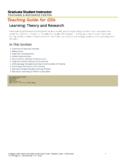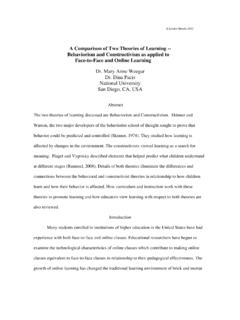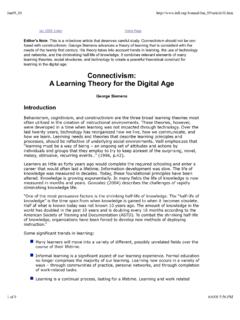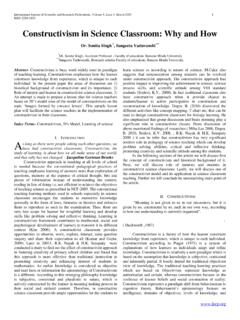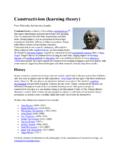Transcription of Theories and Frameworks for Online Education: Seeking an ...
1 Theories and Frameworks for Online Education: Seeking an Integrated Model 166 Theories and Frameworks for Online Education: Seeking an Integrated Model Anthony G. Picciano City University of New York Graduate Center and Hunter College Abstract This article examines theoretical Frameworks and models that focus on the pedagogical aspects of Online education. After a review of learning theory as applied to Online education, a proposal for an integrated Multimodal Model for Online Education is provided based on pedagogical purpose. The model attempts to integrate the work of several other major theorists and model builders such as Anderson (2011). Keywords: Online education, Online learning, blended learning, learning theory, theoretical Frameworks , model building, multimodal model Picciano, A.
2 G. (2017). Theories and Frameworks for Online education: Seeking an integrated model. Online Learning, 21(3), 166-190. doi: Introduction In a provocative chapter of The Theory and Practice of Online Learning, Terry Anderson (2011) examines whether a common theory for Online education can be developed. While recognizing that as a difficult, and perhaps fruitless, task, he nonetheless examines possibilities and proposes his own theory which he admits is not complete. The purpose of this article is to examine theoretical Frameworks relevant to the pedagogical aspects of Online education. It starts with a consideration of learning Theories and funnels down to their specific application to Online education.
3 The article concludes with a proposal for an integrated model for Online education based on pedagogical purpose. Learning Theory Learning theory is meant to explain and help us understand how people learn; however, the literature is complex and extensive enough to fill entire sections of a library. It involves multiple disciplines, including psychology, sociology, neuroscience, and of course, education. Three of the more popular learning Theories behaviorism, cognitivism, and social constructivism will be highlighted to form the foundation for further discussion. Mention will also be made of several other learning Theories that are relevant to Online education.
4 Before reviewing these Theories , it will be worthwhile to have a brief discussion of the term theory itself. Theory is defined as a set of statements, principles, or ideas that relate to a particular subject. A theory usually describes, explains, and/or predicts phenomena. The definition of theory also varies depending upon disciplines, especially when related to the term model. As noted by Graham, Henrie, and Gibbons (2013), the two terms are used interchangeably and generally refer to the same concept. However, a model is more frequently a visual representation of reality or a concept. In this discussion, the terms theory and model will be used interchangeably. The purpose Theories and Frameworks for Online Education: Seeking an Integrated Model 167 of a theory or model is to propose the answers to basic questions associated with a phenomenon.
5 Graham, Henrie and Gibbons (2013) reviewed this issue as related to instructional technology and recommended a three-part taxonomy first proposed by Gibbons and Bunderson (2005) that includes Theories that: Explore: What exists? and attempts to define [describe] and categorize; Explain: Why does this happen? and looks for causality and correlation, and work with variables and relationships. Design: How do I achieve this outcome? and describes interventions for reaching targeted outcomes and operational principles (Graham, Henrie and Gibbons, 2013, p. 13). This taxonomy will serve as an overall guiding principle for the discussion of learning Theories and models in this article.
6 Behaviorism As its name implies, behaviorism focuses on how people behave. It evolved from a positivist worldview related to cause and effect. In simple terms, action produces reaction. In education, behaviorism examines how students behave while learning. More specifically, behaviorism focuses on observing how students respond to certain stimuli that, when repeated, can be evaluated, quantified, and eventually controlled for each individual. The emphasis in behaviorism is on that which is observable and not on the mind or cognitive processes. In sum, if you cannot observe it, it cannot be studied. The development of behaviorism is frequently associated with Ivan Pavlov, famous for his experiments with dogs, food, and audible stimuli, such as a bell.
7 In his experiments, dogs learned to associate food or feeding time with the sound of the bell and began to salivate. Pavlov conducted his experiments in the early 1900s and they were replicated by many other researchers throughout the 20th century. John B. Watson, among the first Americans to follow Pavlov s work, saw it as a branch of natural science. Watson became a major proponent of Pavlov and is generally credited with coining the term behaviorism. He argued that mind and consciousness are unimportant in the learning process and that everything can be studied in terms of stimulus and response. Other major figures associated with behaviorism are Skinner and Edward Thorndike. Skinner is particularly well known, primarily because he introduced what he referred to as operant conditioning which emphasized the use of both positive and negative reinforcement to help individuals learn new behaviors.
8 This was quite different from Pavlov, who relied on simple reflexive responses to specific stimuli although both Pavlov and Skinner promoted repetitive behavior that leads to habit formation. Skinner had a significant influence on early computer-assisted instructional (CAI) models as developed by Pat Suppes and others. A common aspect of early CAI programs was the reliance on encouragement and repetition to promote positive learning activities. Cognitivism Cognitivism has been considered a reaction to the rigid emphasis by behaviorists on predictive stimulus and response (Harasim, 2012, p. 58). cognitive theorists promoted the concept that the mind has an important role in learning and sought to focus on what happens in between the occurrence of environmental stimulus and student response.
9 They saw the cognitive processes of the mind, such as motivation and imagination, as critical elements of learning that bridge Theories and Frameworks for Online Education: Seeking an Integrated Model 168 environmental stimuli and student responses. For example, Noam Chomsky (1959) wrote a critical review of Skinner s behaviorist work in which he raised the importance of creative mental processes that are not observable in the physical world. Although written mainly from the perspective of a linguist, Chomsky s view gained popularity in other fields, including psychology. Interdisciplinary in nature, cognitive science draws from psychology, biology, neuroscience, computer science, and philosophy to explain the workings of the brain as well as levels of cognitive development that form the foundation of learning and knowledge acquisition.
10 As a result, cognitivism has evolved into one of the dominant learning Theories . The future of cognitivism is particularly interesting as more advanced Online software evolves into adaptive and personalized learning applications that seek to integrate artificial intelligence and learning analytics into instruction. Behaviorism led to the development of taxonomies of learning because it emphasized the study and evaluation of multiple steps in the learning process. Behaviorists repeatedly studied learning activities to deconstruct and define the elements of learning. Benjamin Bloom (1956) was among the early psychologists to establish a taxonomy of learning that related to the development of intellectual skills and to stress the importance of problem solving as a higher order skill.










